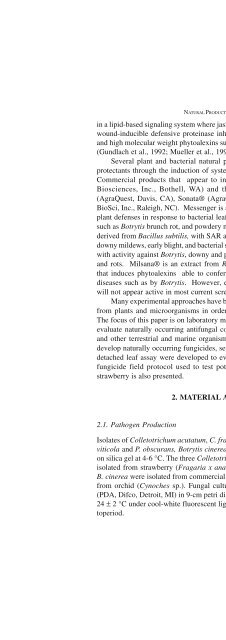Allelochemicals Biologica... - Name
Allelochemicals Biologica... - Name
Allelochemicals Biologica... - Name
Create successful ePaper yourself
Turn your PDF publications into a flip-book with our unique Google optimized e-Paper software.
NATURAL PRODUCT BASED FUNGICIDES 3<br />
in a lipid-based signaling system where jasmonates induce the synthesis of a family of<br />
wound-inducible defensive proteinase inhibitors (Farmer and Ryan, 1992) and low<br />
and high molecular weight phytoalexins such as flavonoids, alkaloids, and terpenoids<br />
(Gundlach et al., 1992; Mueller et al., 1993).<br />
Several plant and bacterial natural products have novel applications as plant<br />
protectants through the induction of systemic acquired resistance (SAR) processes.<br />
Commercial products that appear to induce SAR include Messenger® (EDEN<br />
Biosciences, Inc., Bothell, WA) and the bioprotectant fungicides Serenade®<br />
(AgraQuest, Davis, CA), Sonata® (AgraQuest, Davis, CA), and Milsana® (KHH<br />
BioSci, Inc., Raleigh, NC). Messenger is a harpin protein which switches on natural<br />
plant defenses in response to bacterial leaf spot, wilt, and blight and fungal diseases<br />
such as Botrytis brunch rot, and powdery mildew. Serenade is a microbial-protectant<br />
derived from Bacillus subtilis, with SAR activity that controls Botrytis, powdery and<br />
downy mildews, early blight, and bacterial spot. Sonata is also a microbial-biopesticide<br />
with activity against Botrytis, downy and powdery mildews, rusts, Sclerotinia blight,<br />
and rots. Milsana® is an extract from Reynoutria sachalinensis (giant knotweed)<br />
that induces phytoalexins able to confer resistance to powdery mildew and other<br />
diseases such as by Botrytis. However, elicitors with no innate antifungal activity<br />
will not appear active in most current screening high throughput screening systems.<br />
Many experimental approaches have been used to screen compounds and extracts<br />
from plants and microorganisms in order to discover new antifungal compounds.<br />
The focus of this paper is on laboratory methods and field procedures that we use to<br />
evaluate naturally occurring antifungal compounds produced by plants, pathogens,<br />
and other terrestrial and marine organisms. As part of a program to discover and<br />
develop naturally occurring fungicides, several new in vitro detection systems and a<br />
detached leaf assay were developed to evaluate small amounts of compound. Our<br />
fungicide field protocol used to test potential lead fungicides using commercial<br />
strawberry is also presented.<br />
2.1. Pathogen Production<br />
2. MATERIAL AND METHODS<br />
Isolates of Colletotrichum acutatum, C. fragariae and C. gloeosporioides, Phomopsis<br />
viticola and P. obscurans, Botrytis cinerea and Fusarium oxysporum are maintained<br />
on silica gel at 4-6 °C. The three Colletotrichum species and P. obscurans strain were<br />
isolated from strawberry (Fragaria x ananassa Duchesne). Phomopsis viticola and<br />
B. cinerea were isolated from commercial grape (Vitis vinifera L.) and F. oxysporum<br />
from orchid (Cynoches sp.). Fungal cultures were grown on potato-dextrose agar<br />
(PDA, Difco, Detroit, MI) in 9-cm petri dishes and incubated in a growth chamber at<br />
24 ± 2 °C under cool-white fluorescent lights (55 ± 5 µmols/m 2 /sec) with a 12h photoperiod.


